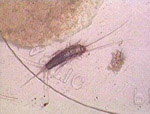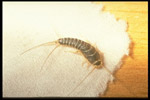|
|
Overview | |
Thysanura are primitive but well-adapted to survive in domestic environments such as basements and attics. They are nocturnal scavengers or browsers, hiding under rocks or leaves during the day. They survive on a wide range of food, but prefer algae, lichens, or starchy vegetable matter. N.C. State University Entomology Dept.
Thysanura is thought to be the linking order between wingless and winged insects, and members of
this order are some of the primitive insects known to man. --
(Earth Life)
Since they are common household pests, thysanurans have been given many different eccentric names.
For example, they are sometimes called "fish-moths" because of their covering of scales and their
moth-like persistence as pests. Their silvery body and tendency to hang out in damp places has
given rise to the name "silverfish." -- (Kellogg, 1905) The other most common name is "firebrat,"
given because they often inhabit warm places such as fireplaces and bakeries. Thysanurans are also
called "bristletails" because of the bristle-like appendages on the tip of their abdomens. --
( Britannica.com)
|
|
|
Identification |
Adults and immatures:
- Body relatively flat, tapered and often covered with scales
- Compound eyes small or absent
- Antennae long, thread-like, and multisegmented
- Abdomen with ten complete segments
- Eleventh abdominal segment elongated to form a median caudal filament
- Cerci present, nearly as long as median caudal filament
- Styliform appendages located on abdominal segments 7-9
-- (N.C. State University Entomology Dept.)
The firebrat can also be brown or tan in color. Thysanurans are usually about 12 mm in length. -- (Borror et al., 1989)
|
|
|
Families |
|
| Lepidotrichidae -- Represented in the United States by a single species, Tricholepidion gertschi.
|
|
| Nicoletiidae -- Represented by two subfamilies, Nicoletiinae and Atelurinae, which differ
in appearance and habits. The Nicoletiinae are subterranean, slender in appearance, and lack
scales; the Atelurinae are free-living, oval in appearance, and have scales.
|
|
| Lepismatidae -- Contains the common domestic species of silverfish and firebrats.
|
|
|
|
Phylogeny |
| Taxonomic Category
| Scientific Name
| Common Name
|
| Phylum
| Arthropoda
| Arthropods
|
| Class
| Insecta
| Insects
|
| Order
| Thysanura
| Silverfish, Bristletail, & Firebrat
|
|
|
|
Photographs |

| 
|
| [Thysanuran sp.] Photo copyright UC Berkeley
| [Species: Lespisma sacchrina Photo copyright
Drees
|
|
|
|
Geographic distribution |
Thysanurans are worldwide in distribution where their favorable habitats exist: soil, leaf litter, houses, and even termite nests.
-- ( Britannica.com)
|
|
|
Natural history | |
After hatching, the nymphs change to adults with minimal metamorphosis. The young are similar to
adults except in size, molting until sexual maturity is attained. Molting may continue into adulthood,
and there may be more than forty molts in the life of a thysanuran. They feed on decaying or dried
vegetable material, animal remains, and domestic species feed on starchy material such as paper, binding,
and artificial silk. -- ( Britannica.com)
Members of Thysanura do not copulate. Instead, the male uses his genitalia to deposit sperm packets,
and the female picks it up and places it in her vagina. The oval, whitish eggs are thought to be
inserted into cracks and soil litter.
-- (Britannica.com)
|
|
|
How to encounter | |
Indoor species can be trapped or collected with forceps or a moistened brush. Outdoor species can
be collected by searching in damp places: in soil, under rocks or wood, in leaf litter, or even in
moss. The outdoor species can also be collected with forceps or a brush. At night you can shine a
light in places where they occur and in less than half an hour they usually start crawling towards
it. - (Borror et al., 1989)
Control of domestic species may not be necessary if only a few are present or if damage is limited
to small areas. Eliminating moisture problems where the pests can develop may be of some benefit.
Household residual insecticides applied as sprays, dusts, or baits can be used if necessary and safe.
Focus on cracks, niches, and other likely hiding spots in the areas where the pests are noticed. A
typical 'over the counter' pest spray such as "Raid" may be helpful. Boric acid dust, which is low
in toxicity and long lasting, and household pest baits can also be used. --
(Iowa State Insect Notes)
|
|
|
Links to other sites | |
|
|
|
References |
- Borror, Donald J., Norman F. Johnson, and Charles A. Triplehorn. An Introduction to the Study
of Insects. Philadelphia: Saunders College Publishing. 1989. 6th ed.
- Kellogg, Vernon L. American Insects. New York: Henry Holt and Company. 1905.
|
|
|
Acknowledgements |
Stephen Boyd, Scientific illustration major at the University of Georgia, Athens Ga.
Thanks to Sabina Gupta, Denise Lim, and Dr. John Pickering for technical and web support in developing this page.
Special Thanks to: David R. Maddison, U.C. Berkeley, Drees at Texas A&M, Iowa State University, and Virginia Polytechnic Institute and State University
|
|
| Supported by | |
|
Following modified from University of Guelph
|
Top | See original
| &pull 20q v5.145 20180528: Error 301 Moved Permanently http://www.uoguelph.ca/debu/STEVEweb/html/Thysanura.htm |
|
Following served from John R. Meyer, North Carolina State University Department of Entomology |
Top | See original context
|
Following modified from BioKIDS University of Michigan
|
Top | See original
Skip directly to
main content
.

Kids' Inquiry of Diverse Species

This scientific name is not yet recognized in our classification database.
Thysanura
What do they look like?
-
Sexual Dimorphism
-
sexes alike
-
-
Range length
-
7.0 to 19.0 mm
-
0.28 to 0.75 in
Where do they live?
There are around 370 species from four different families in the order Thysanura. Their distribution is worldwide.
What kind of habitat do they need?
Silverfish live under bark, leaf litter, in caves and other underground dwellings, including mammal burrows. Some species are found in buildings associated with humans. Silverfish can exist under extreme environments. Some tolerate wet, cool regions, and others tolerate the low humidity and high temperatures of arid regions.
How do they grow?
Molting occurs throughout the life of the insect. It takes up to two years for a silverfish to complete its development from juvenile to adult.
How long do they live?
Silverfish can live up to four years.
-
-
Range lifespan
Status: wild
-
4.0 (high) years
How do they behave?
Despite being wingless, silverfish are rapid runners.
What eats them and how do they avoid being eaten?
What roles do they have in the ecosystem?
Commensal or parasitic species (or larger taxonomic groups) that use this species as a host
Do they cause problems?
-
Ways that these animals might be a problem for humans
-
household pest
How do they interact with us?
Silverfish that are outdoor species are useful decomposers of organic materials.
Some more information...
Collecting: Silverfish may be collected from buildings by placing strips of paper at the edge of a small jar and making a ramp to the floor. Place a bit of dried fruit, raisin, oatmeal or cracker in the jar and check it every day. If silverfish are around, you'll trap them in the jar. Place the trap in an attic, storage room, or cellar for best results. They can also be collected from leaf litter using a Berlese funnel and jar. Outdoors, Silverfish are also found under bark and stones and in fungi. A moist brush will pick them up. Preserve silverfish in 75% ethanol.


BioKIDS home
|
Questions?
|
Animal Diversity Web
|
Cybertracker Tools
. "" (On-line), Animal Diversity Web. Accessed May 09, 2024 at http://www.biokids.umich.edu/accounts//
BioKIDS is sponsored in part by the Interagency Education Research Initiative. It is a partnership of the
University of Michigan
School of Education
,
University of Michigan
Museum of Zoology
, and the
Detroit Public Schools
. This material is based upon work supported by the
National Science Foundation
under Grant DRL-0628151.
Copyright © 2002-2024, The Regents of the University of Michigan. All rights reserved.

|
ERROR -- Need to remove recursive link: http://www.discoverlife.org/nh/id/lucid/Insect_orders/html/Thysanura.html Lucid via Discover Life
Updated: 2024-05-09 16:58:35 gmt
|
